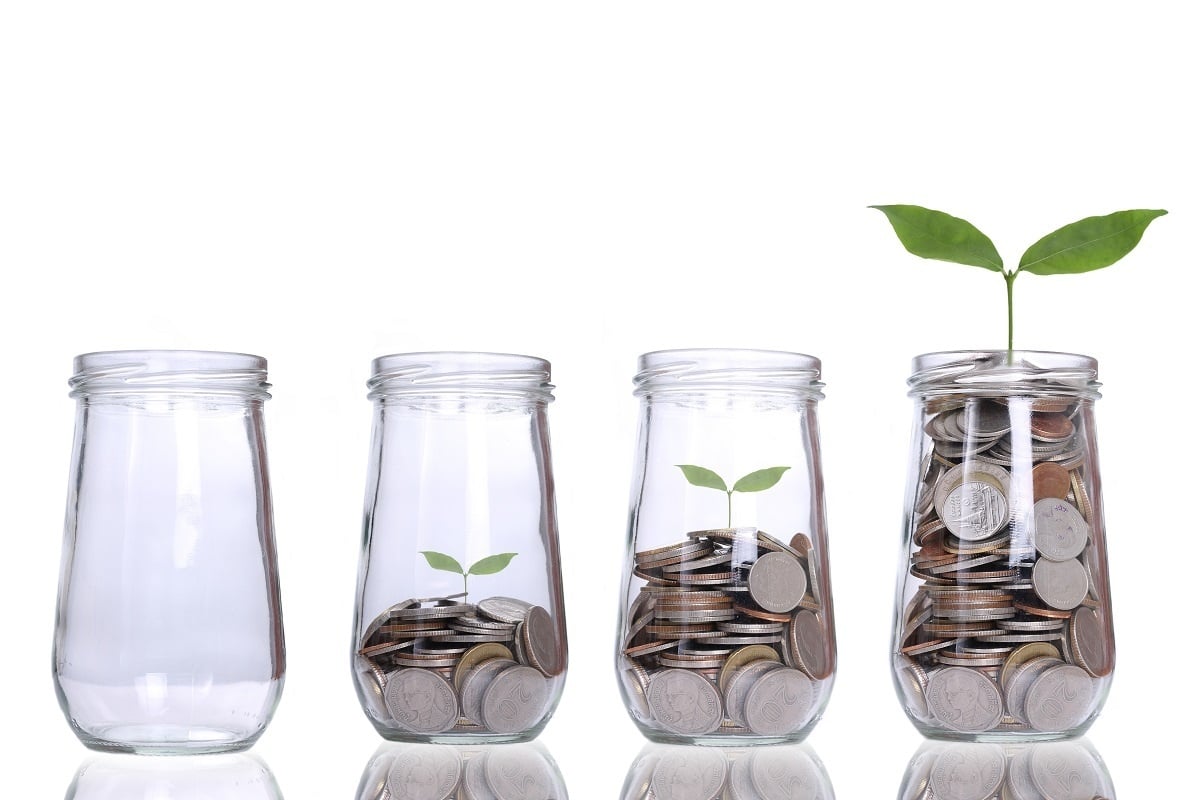Think lowering your price is the only way to increase sales? Think again.
 PriceBeam
·
5 minute read
PriceBeam
·
5 minute read
There is a wide misconception that lowering the price of your product or service will always increase sales. Lowering the price may increase sales, or it may decrease sales, just as increasing the price may increase sales or may decrease sales. It’s scary not knowing which way sales would go when you change the price…
So let’s examine this.
First, why do most people believe that lowering the price always increases sales?
Well, there are many reasons. First, most vendors believe that price, whatever the price is, generates “price friction,” and lower prices would equal lower friction. Those who attended business school were taught a demand curve looking like this:

Or like this:
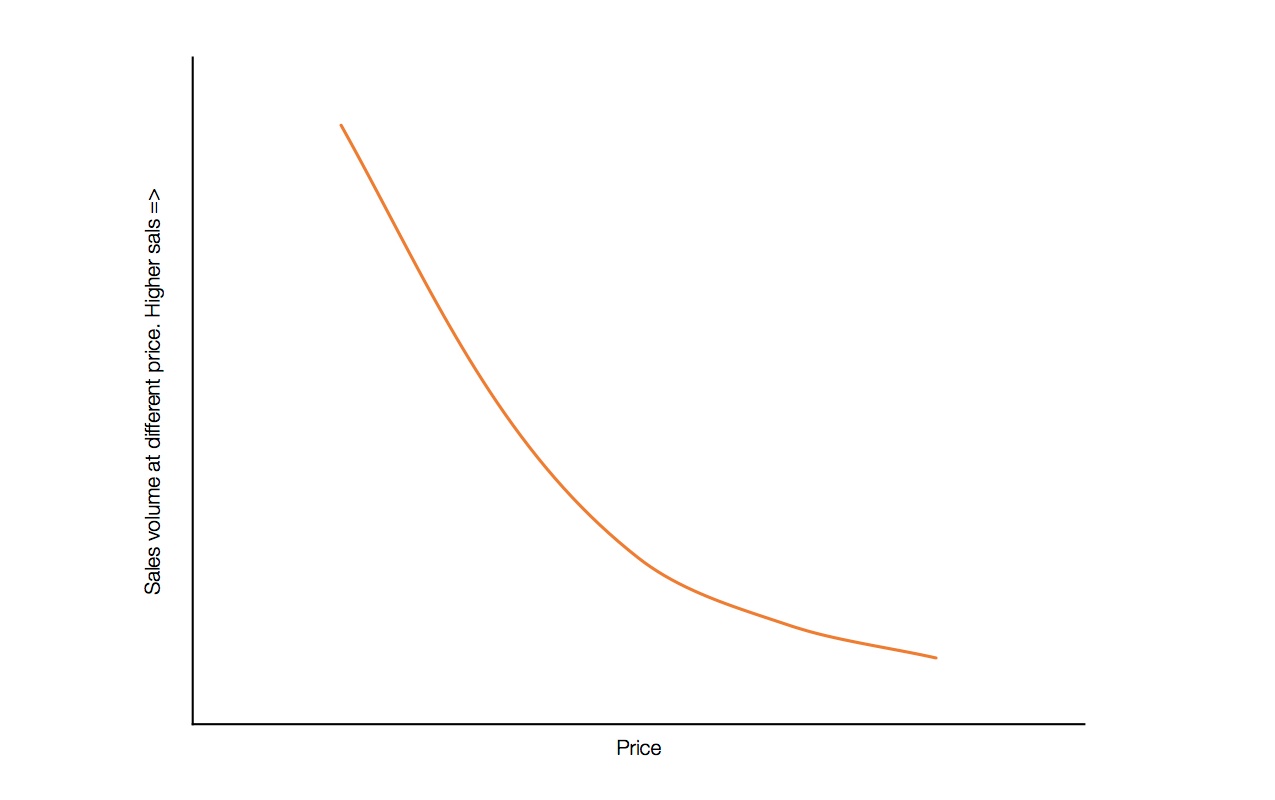
Neither of these demand curves are correct, and to emphasize the absurdity of these curves, if they were true, at a price of zero, sales would be infinite. Never happens. Of course it doesn’t. (Here’s a funny story: I recall the straight line growth projections of the airline industry from back in the late 1980s or early 1990s. Plotted out, by now in 2017, every man, woman and child on the planet would be flying 24 hours a day, 7 days a week. I’m pretty sure that didn’t happen. But both plane makers and airlines use these absurd projections for strategic planning. Same with these traditional demand curves.)
Another reason is just that we look at ourselves, and think how we react to prices. Lower is better. But there is a twist here. When it comes to your products or services, you know the quality and the benefits your product or service provides. Your potential customer doesn’t. They will evaluate what you sell based on the marketing and sales material they may have read and watched, the interaction with your company online and with people in the firm, along with the experiences of others who may have used your product or service. And the price. In fact, among all these variables, the price is the most important because the price of your product or service is also the most important message of quality and benefit. If the price does not match with the value perceptions your potential customer gained from the interaction with your company, or the marketing and sales literature, website, or interactions with your sales people, you will either not sell it or you will leave money on the table. I will cover that in more details below.
Having said that, everybody still wants a bargain, and because of that, if you sell through sales people, your customers still will try to negotiate the price down. They will tell you stories about how high your price is, how poor the product or service is, how much better value for money the competition’s products or services are. They will withhold what they really think and dream up reasons why you should lower the price. Sometimes they will outright lie! Of course, not every customer does this every time, but most do it some of the time. This constant barrage dismissing the value of your product or service, over time, grinds down sales peoples’ confidence in what they sell. They become less and less able to defend your value and will discount your product or service. They want a lower price too, and discount heavily and sometimes convince the company they work for to lower the price.
But, you may ask, how can lower prices sometimes lead to lower sales while discounted prices lead to higher sales? It is because the original price becomes the anchor for the value and the benefit a product or service delivers to the buyer, and those value perceptions do not change if discounts are provided. To a point…
Well, as I alluded to above, pricing sends a message about quality and benefit of your product or service. See below:

This is a chart for a specific type of business-to-business service. You can see how demand is highest between $100 and $200, and how below $100, the lower the price, the lower the projected sales volume. This is because the low pricing becomes a message of decrease in quality and benefit. Above $200, sales volumes also taper off; the higher the price, the lower the sales. I’m going to repeat this chart several times as we review different scenarios.
It is obvious that depending on your current price, lowering the price may or may not affect sales volume:
So, in these scenarios:
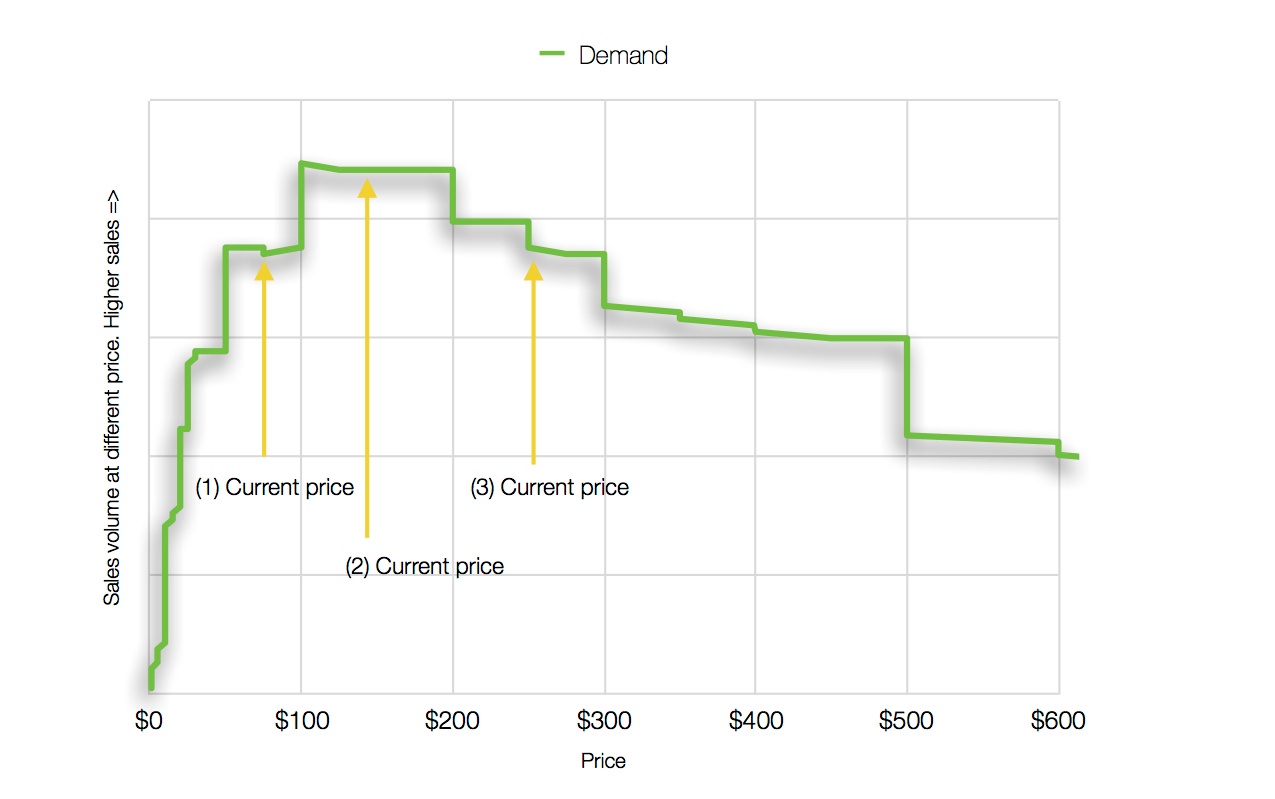
(1) Lowering the price slightly will have no effect on sales volume, and lowering it from $75 to $50 or below will result in a drop in sales volume.
(2) Lowering the price slightly will have no effect on sales volume, and lowering it from $150 to $100 or below will result in a drop in sales volume.
(3) Lowering price slightly will increase sales volume slightly, and lowering from $250 to $200 will generate a higher sales increase.
But, you may say: “We know where on this curve our prices are.” “We know we have the right price.” “We looked at the competition and got a good sense of where the price should be.” Really?
This is the actual price charged by the company. They offered their service at two price points: a discounted price of $60 for those who pre-ordered, and a regular price of $90. (It is the same chart as before, with a different X scale to make the price points easier to see.)
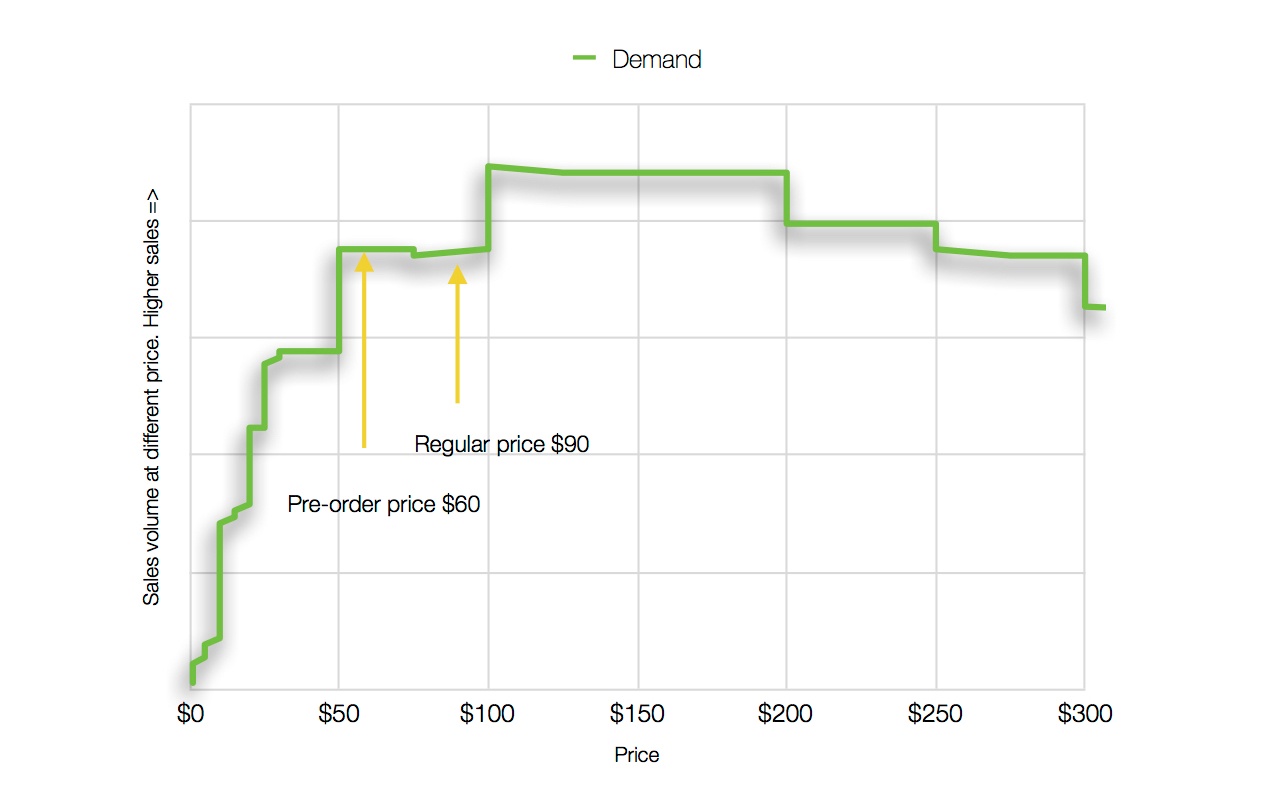
The company made a point of maintaining close contact with their customers: they held customer conferences, surveyed customers and collected lots of data from their sales peoples’ interactions with customers. Yet, they got the price wrong. Because of the reason mentioned above: their customers downplayed the value they got from the company’s service.
So what would happen here if prices were discounted? Well, if the price for the pre-ordered service would drop below $50, sales would tumble. If the regular price was discounted, there will be no change in sales volume, until it was discounted down to below $50 again. The only practical results of lowering prices would have been to leave more money on the table.
If you want to increase sales, and you have these demand curves for your product or service, how do you change the price? In this case, it is to increase the price. Substantially. So let’s see what price the chart will lead us to:
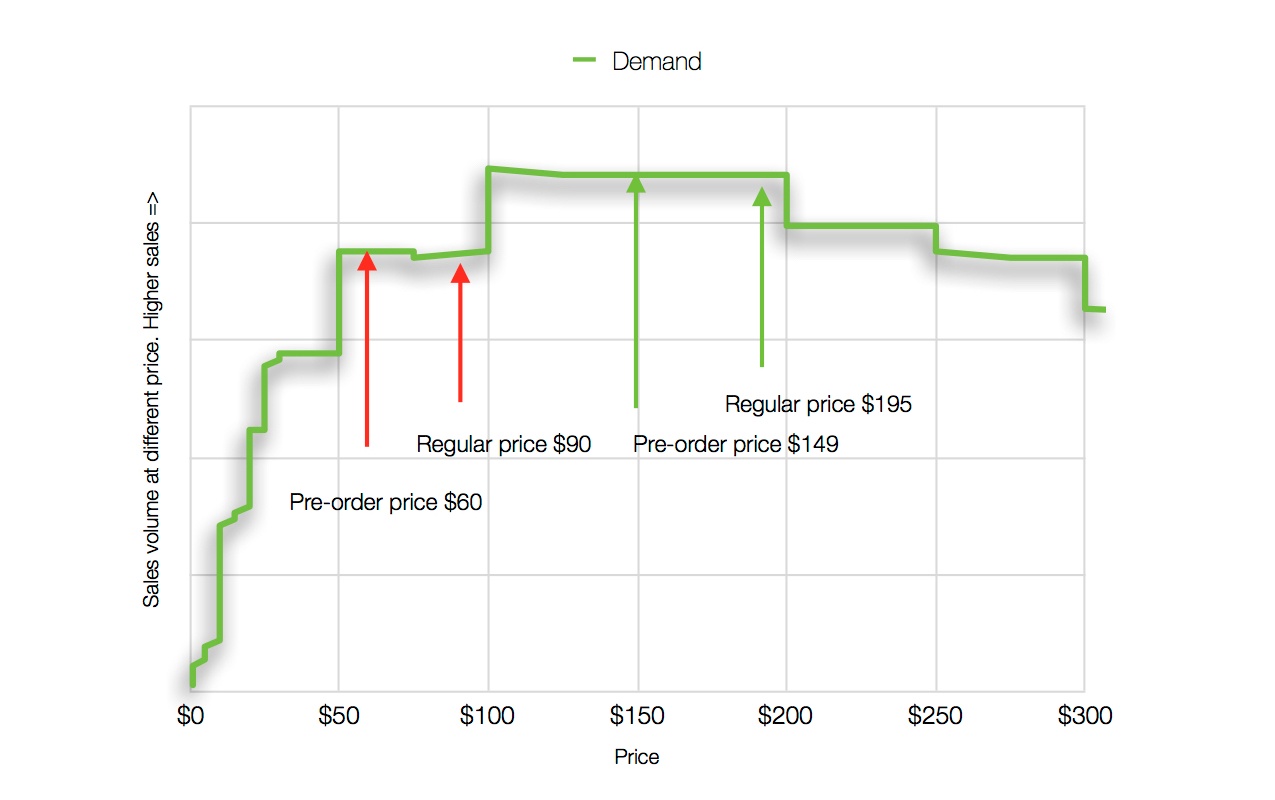
The regular price can go up from $90 to $195 and the discounted pre-order price can go up from $60 to $149. There is a reason for the selection these particular prices points. The regular price is set at $195, and not $199 because the message the price conveys; a price of $199 becomes more of “we want every dollar you can spare” message whereas $195 softens that perceptions in the marketplace. Furthermore, if you look for the psychological price points, you will see that demand changes at $50 intervals, and that is the reason for the selected discounted pre-order price of $149; a clean $50 below the demand max at $199.
What I’ve been trying to convey in this blog post is that lowering the price does not always increase sales and, in fact, a discounted price can be like shooting yourself in the foot. But with these demand curves you can make data-driven decisions and don’t have worry about what will happen with your sales if you decide to discount.
In closing, let me tell you a story of a company that made one price change, and almost died. The company sells high-end home theater processors and amplifiers. Their best selling product had a list price of $3,200. Their sales people, believing firmly that their customers were right in asking for discounts, eventually convinced the company to lower the list price to $2,800. Sales fell off a cliff. Down some 40 - 50% at the lower price. But the company could not just raise the price again and had to develop a new version of the product in order to regain its historical sales volume. A long process that almost killed the company.
.png?width=400&height=100&name=PBLogoTransparent%20(1).png)

